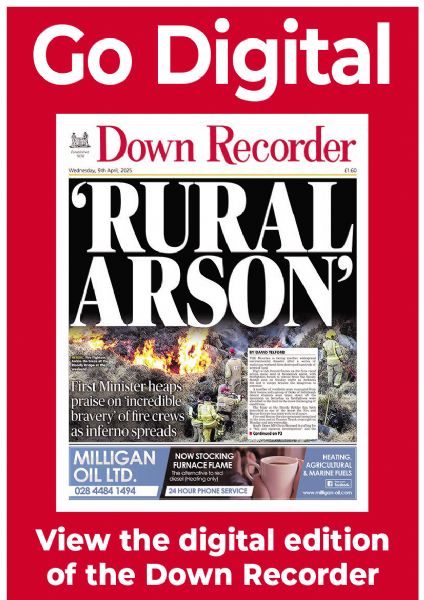Bobbie pictures and Steafán’s words give meaning to Troubles
Bobbie pictures and Steafán’s words give meaning to Troubles
BOBBIE Hanvey has taken countless thousands of photos down the years — far too many to remember them all, he says — but a select few are contained in a new book which focuses on life in Northern Ireland during the Troubles.
In a distinguished and colourful career, the Downpatrick photographer has expertly trained his lens on people from all walks of life and witnessed good times and bad.
Reconstructions, which was launched in Belfast last week, is a selection of photos spanning 40 years dating back to the early 1970s. What makes this book unique is that each photo is accompanied by a poem written by Bobbie’s son, Steafán, a richly talented poet and songwriter, who now lives in Finland.
Some of the photos are a reminder of a sad and tragic time which many would prefer to forget, such as the malicious fire which engulfed the premises of Downpatrick building contractor Hugh J O’Boyle in 1975, or the devastation done to the centre of Ballynahinch by an IRA bomb ten years later.
The weariness of the Troubles is captured on the face of man smoking a cigarette and walking way from another bomb blast in Belfast in the early 1970s; the horror of it all by a photo taken in a lonely alleyway of retired RUC Detective Chief Inspector Jimmy Nesbitt — the man who captured the notorious Shankill Butchers, who were responsible for some of the most brutal and cold-blooded murders of the Troubles.
Rightly included is perhaps Bobbie’s most celebrated photo, taken in 1985, of DUP leader the Rev Ian Paisley with his arm raised beside the statute of Sir Edward Carson at Stormont.
The late Dr Paisley’s son, Ian Jr, was present at last week’s launch at No Alibis bookshop in Belfast, which was filled to capacity for the occasion. Among the many people also present were Assistant Deputy Chief Constable Stephen Martin, UDA leader Jackie McDonald and former Sinn Fein activist Danny Morrison, as well as a number of local people.
“I was delighted that so many people turned up, not for myself, but for Steafán, who has put all of the work into the book,” Bobbie says. “It is his idea and he has brought it fruition. I am very proud of him.”
Born in Brookeborough in Co Fermanagh, Bobbie came to Downpatrick in 1966 and worked as a psychiatric nurse at the Downshire Hospital before switching careers to become a photographer.
It proved to be a successful move.
Over the years his photos have appeared in many publications and he has made many friends throughout Ireland and beyond. He has won numerous awards and his hugely popular Downtown Radio programme, The Ramblin Man, ran for 36 years.
Many of his photos have appeared in the Down Recorder, where he was a valued freelance photographer for many years and which he credits for giving him a head start in photography.
“I learned everything at the Recorder, particularly from Andy Campbell, who was the main photographer, and the paper’s owner, Colin Crichton,” he said. “I was sent to cover stuff I would never normally have seen — explosions, shooting and fires, as well as cheque presentations and darts matches. You got it all at the Recorder.”
Bobbie says the Troubles were like an adrenalin switch. “There were incidents happening all the time and you went to them. You switched on and you switched off. A lot of what happened was very sad, particularly if you knew the people involved.
“I managed to get my hands on a police radio scanner, which told you what was happening. I had it on all the time. When I knew something local happened I would be up and away, even in the middle of the night. Many a time Steafán would be dressed already and waiting to go with me.”
Aged 73 and still full of enthusiasm, Bobbie’s as busy as ever, though he says he does what he wants to do and leaves the rest. He still takes commissions and is already working on another book.
He rejects any suggestions that Reconstructions is some form of legacy for him to be remembered by.
“I don’t believe in legacies or posterity. People won’t remember me when I die. When you die and go to heaven, or wherever else, that’s the end of it.”
Reconstructions is published by Merrion Press.


